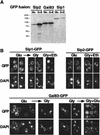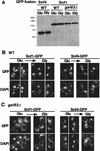Subcellular localization of the Snf1 kinase is regulated by specific beta subunits and a novel glucose signaling mechanism
- PMID: 11331606
- PMCID: PMC312685
- DOI: 10.1101/gad.879301
Subcellular localization of the Snf1 kinase is regulated by specific beta subunits and a novel glucose signaling mechanism
Abstract
The Snf1/AMP-activated protein kinase family has broad roles in transcriptional, metabolic, and developmental regulation in response to stress. In Saccharomyces cerevisiae, Snf1 is required for the response to glucose limitation. Snf1 kinase complexes contain the alpha (catalytic) subunit Snf1, one of the three related beta subunits Gal83, Sip1, or Sip2, and the gamma subunit Snf4. We present evidence that the beta subunits regulate the subcellular localization of the Snf1 kinase. Green fluorescent protein fusions to Gal83, Sip1, and Sip2 show different patterns of localization to the nucleus, vacuole, and/or cytoplasm. We show that Gal83 directs Snf1 to the nucleus in a glucose-regulated manner. We further identify a novel signaling pathway that controls this nuclear localization in response to glucose phosphorylation. This pathway is distinct from the glucose signaling pathway that inhibits Snf1 kinase activity and responds not only to glucose but also to galactose and sucrose. Such independent regulation of the localization and the activity of the Snf1 kinase, combined with the distinct localization of kinases containing different beta subunits, affords versatility in regulating physiological responses.
Figures








Similar articles
-
Pak1 protein kinase regulates activation and nuclear localization of Snf1-Gal83 protein kinase.Mol Cell Biol. 2004 Sep;24(18):8255-63. doi: 10.1128/MCB.24.18.8255-8263.2004. Mol Cell Biol. 2004. PMID: 15340085 Free PMC article.
-
The Snf1 protein kinase and its activating subunit, Snf4, interact with distinct domains of the Sip1/Sip2/Gal83 component in the kinase complex.Mol Cell Biol. 1997 Apr;17(4):2099-106. doi: 10.1128/MCB.17.4.2099. Mol Cell Biol. 1997. PMID: 9121458 Free PMC article.
-
The beta-subunits of the Snf1 kinase in Saccharomyces cerevisiae, Gal83 and Sip2, but not Sip1, are redundant in glucose derepression and regulation of sterol biosynthesis.Mol Microbiol. 2010 Jul;77(2):371-83. doi: 10.1111/j.1365-2958.2010.07209.x. Epub 2010 Jun 10. Mol Microbiol. 2010. PMID: 20545859
-
AMPK in Yeast: The SNF1 (Sucrose Non-fermenting 1) Protein Kinase Complex.Exp Suppl. 2016;107:353-374. doi: 10.1007/978-3-319-43589-3_14. Exp Suppl. 2016. PMID: 27812987 Review.
-
Transcriptional control of nonfermentative metabolism in the yeast Saccharomyces cerevisiae.Curr Genet. 2003 Jun;43(3):139-60. doi: 10.1007/s00294-003-0381-8. Epub 2003 Apr 25. Curr Genet. 2003. PMID: 12715202 Review.
Cited by
-
The glucose signaling network in yeast.Biochim Biophys Acta. 2013 Nov;1830(11):5204-10. doi: 10.1016/j.bbagen.2013.07.025. Epub 2013 Aug 2. Biochim Biophys Acta. 2013. PMID: 23911748 Free PMC article. Review.
-
A homologue of AMP-activated protein kinase in Drosophila melanogaster is sensitive to AMP and is activated by ATP depletion.Biochem J. 2002 Oct 1;367(Pt 1):179-86. doi: 10.1042/BJ20020703. Biochem J. 2002. PMID: 12093363 Free PMC article.
-
N-myristoylation regulates the SnRK1 pathway in Arabidopsis.Plant Cell. 2007 Sep;19(9):2804-21. doi: 10.1105/tpc.107.051870. Epub 2007 Sep 7. Plant Cell. 2007. PMID: 17827350 Free PMC article.
-
On gene dosage balance in protein complexes: a comment on Semple JI, Vavouri T, Lehner B. A simple principle concerning the robustness of protein complex activity to changes in gene expression.BMC Syst Biol. 2009 Jan 30;3:16. doi: 10.1186/1752-0509-3-16. BMC Syst Biol. 2009. PMID: 19183469 Free PMC article.
-
Interaction of SNF1 protein kinase with its activating kinase Sak1.Eukaryot Cell. 2011 Mar;10(3):313-9. doi: 10.1128/EC.00291-10. Epub 2011 Jan 7. Eukaryot Cell. 2011. PMID: 21216941 Free PMC article.
References
-
- Alepuz PM, Cunningham KW, Estruch F. Glucose repression affects ion homeostasis in yeast through the regulation of the stress-activated ENA1 gene. Mol Microbiol. 1997;26:91–98. - PubMed
-
- Ashrafi K, Farazi TA, Gordon JI. A role for Saccharomyces cerevisiae fatty acid activation protein 4 in regulating protein N-myristoylation during entry into stationary phase. J Biol Chem. 1998;273:25864–25874. - PubMed
-
- Beck T, Hall MN. The TOR signalling pathway controls nuclear localization of nutrient-regulated transcription factors. Nature. 1999;402:689–692. - PubMed
-
- Carlson M. Glucose repression in yeast. Curr Opin Microbiol. 1999;2:202–207. - PubMed
Publication types
MeSH terms
Substances
Grants and funding
LinkOut - more resources
Full Text Sources
Other Literature Sources
Molecular Biology Databases
Research Materials
